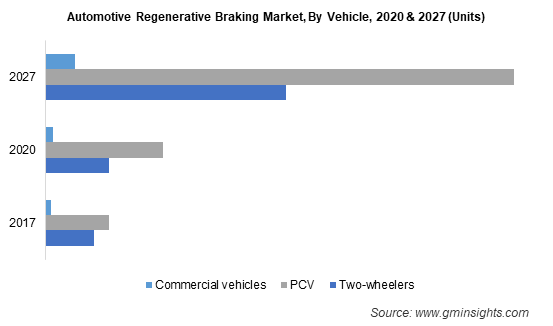Home > Automotive > Automotive Parts > Tires and Wheels > Automotive Regenerative Braking Market
Automotive Regenerative Braking Market Analysis
- Report ID: GMI4643
- Published Date: Aug 2021
- Report Format: PDF
Automotive Regenerative Braking Market Analysis
The battery electric vehicles propulsion is set to account for more than 45 million units demand by 2027. Increasing adoption and implementation of systems to enhance vehicle efficiency will significantly boost the industry growth potential. Increasing battery range and energy recovery of vehicles play a significant role by converting vehicle kinetic energy into electricity through motor generators.
Strong government regulations to control environmental pollution and reduce vehicle emissions are encouraging automobile & OEM manufacturers to use developed regenerative braking systems.
The automotive regenerative braking market from passenger cars is anticipated to cross USD 11.5 billion by 2027 owing to increasing vehicle sales globally. Additionally, automobile OEMs are focusing on launching a wide range of regenerative braking systems across a diversified price range for different vehicle models including hatchbacks, sedans, SUVs, MPVs, and crossovers. Automobile manufacturers are incorporating innovative regenerative braking systems in their vehicles to enhance customer experience by reducing CO2 emissions and increasing electric vehicle range.

North America automotive regenerative braking market size is forecast to register a growth rate of above 25% during 2021 to 2027 on account of increasing government initiatives to develop infrastructure for electric vehicles. In June 2021, the Canada government announced an investment of about USD 2.35 million for the installation of EV fast chargers in the country. Moreover, tax rebates on electric vehicles and a strict car scrappage policy will propel the industry growth.
Asia Pacific held over 75% of the market revenue share in 2020 driven by the presence of multiple electric vehicle manufacturers, such as Toyota, SAIC, BAIC, Mitsubishi & Honda. Industry participants are expanding their production facilities in countries including India, Japan, and China to serve a larger consumer base.

